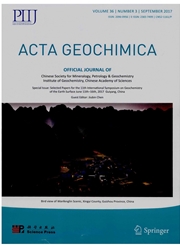

 中文摘要:
中文摘要:
准噶尔盆地白垩系含油气系统理论上具备一定的勘探能力,但研究程度较低。为加深对该问题的理解,分析了白垩系的烃源岩和原油地球化学特征,并进一步结合地质背景,探讨了勘探潜力。结果发现,白垩系发育有一定数量和规模的泥质烃源岩,存在有机碳TOC含量大于1.0%的样品,类型以Ⅱ型为主,目前主体处于低成熟—成熟演化阶段,因此可望具有一定的生烃,特别是生油潜力。油源对比发现白垩系的确有过原油生成,典型地球化学特征表现为轻碳同位素(-29.6‰--27.9‰)、低Pr/Ph值(0.54-1.01)、高伽马蜡烷丰度(伽马蜡烷/C30藿烷=0.29-0.53),反映属于一类还原和盐度环境中有机质所生原油。这类原油主要分布在盆地南缘白垩系烃源岩的沉积中心区,表现出源控特征。这些认识可供国内外其他白垩系油气地质研究时类比考察。
 英文摘要:
英文摘要:
The Cretaceous petroleum system in the Junggar Basin holds exploration potential theoretically,but has relatively limited research. In order to provide basic data for petroleum exploration of the Cretaceous petroleum system in the Junggar Basin,this paper studied the potential hydrocarbon resources by comprehensive geochemical analyses on source rocks and crude oils in combination with geological background. Analytical results indicated that the Cretaceous strata hosted a certain number of source rocks,whose TOC contents are greater than 1. 0%,organic matters are mainly type II kerogen and currently are lowly mature to mature. The Cretaceous is expected to have certain hydrocarbon,especially oil-generation potential. The oil-source correlation supports this conclusion. The representative Cretaceous-derived oils have main geochemical characteristics as follows: light carbon isotopes(-29. 6‰ --27. 9‰),low Pr/Ph values( 0. 54-1. 01),high gammacerane abundance( gammacerane/C30 hopane = 0. 29-0. 53). These reflected that the oils were formed in reducing and saline environment. Cretaceous-sourced oils distributed mainly in the southern margin of the basin,in particular the sedimentary center of the Cretaceous source rocks,showing the source-control characteristics. In summary,the petroleum exploration of the Cretaceous petroleum system in the Junggar Basin should be focused on oil and in the southern basin margin. These results and understandings can also be referred by other studies relevant to Cretaceous hydrocarbon geology.
 同期刊论文项目
同期刊论文项目
 同项目期刊论文
同项目期刊论文
 期刊信息
期刊信息
